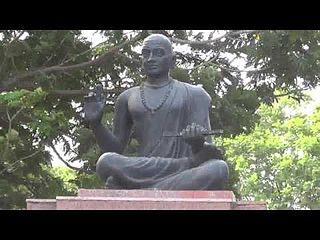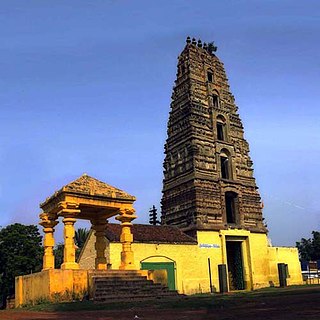Related Research Articles

Tikkana (1205–1288) was a 13th century Telugu poet. Born into a Telugu-speaking Niyogi Brahmin family during the golden age of the Kakatiya dynasty, he was the second poet of the "Trinity of Poets " that translated Mahabharata into Telugu. Nannaya Bhattaraka, the first, translated two and a half chapters of Mahabharata. Tikkana translated the final 15 chapters, but did not undertake translating the half-finished Aranya Parvamu. The Telugu people remained without this last translation for more than a century, until it was translated by Errana.

The Kakatiya dynasty was a Telugu dynasty that ruled most of eastern Deccan region in present-day India between 12th and 14th centuries. Their territory comprised much of the present day Telangana and Andhra Pradesh, and parts of eastern Karnataka, northern Tamil Nadu, and southern Odisha. Their capital was Orugallu, now known as Warangal.

Rudrama Devi, also known by her regnal name Rudra-deva Maharaja, was a Kakatiya queen who ruled substantial parts of present-day Telangana and Andhra Pradesh in southern India. She was among the few successful female rulers in Indian history.

Ramappa Temple, also known as the Rudreshwara temple, is a Kakatiya style Hindu temple dedicated to the Hindu god Shiva, located in Palampet village, Mulugu district, Telangana, India. It is 15 km (9.3 mi) from Mulugu, 66 km (41 mi) from Warangal, 209 km (130 mi) from Hyderabad. An inscription in the temple says it was constructed in the year 1213 CE by Recharla Rudra Reddy—a general of Kakatiya ruler Ganapati Deva. Located in the vicinity of Ramappa Lake, the Ramappa Temple complex which consist of three temples was constructed between 1212 and 1234, designed and architect by Ramappa—after whom the temple complex is named. Marco Polo, during his visit to the Kakatiya empire, supposedly called the temple "the brightest star in the galaxy of temples". In July 2021, Ramappa Temple was declared as a UNESCO World Heritage Site.

Chebrolu is a village in Guntur district of the Indian state of Andhra Pradesh. It is the headquarters of Chebrolu mandal in Tenali revenue division. It was once a Buddhist site and territorial capital of Kakatiya dynasty. The Archaeological excavations revealed Buddhist artefacts of Satavahana and Ikshavaku period.

Perini Shivathandavam or Perini Thandavam is an ancient dance form from Telangana which has been revived in recent time. It prospered during the Kakatiya dynasty. Perini is performed in honour of Lord Shiva, the Hindu God and it is believed that in ancient times this was performed before the soldiers set to war. Nataraja Ramakrishna revived the art form by studying old manuscripts and sculptures at Ramappa Temple.
Pratāparudra, also known as Rudradeva II, was the last monarch of the Kakatiya dynasty of India. He ruled the eastern part of Deccan, with his capital at Warangal.
Vijaya Ganda Gopalan was a king of Nellore Chodas who ruled over Southern Andhra and Kanchi from 1248 to 1263 CE. He was ruling along with his brothers Manumasiddha III and Allutikka.
Prola II was a Kakatiya chief who ruled the area around Anumakomda as a vassal of the Kalyani Chalukyas. He was the father of Rudra-deva, the first sovereign ruler of the Kakatiya family.
Gunda III, also known as Gundyana or Gundana, was a member of the Kakatiya dynasty of southern India. He served the Rashtrakuta king Krishna II, and died during Krishna's invasion of the Vengi Chalukya kingdom. He is the earliest known member of the Kakatiya family to have been in the Telugu-speaking region.
Gunda IV alias Pindi-Gunda was a member of the Kakatiya dynasty of southern India. As a Rashtrakuta general, he helped the Vengi Chalukya prince Danarnava ascend the throne after a succession dispute. In 973 CE, after the collapse of the Rashtrakuta empire and the murder of Danarnava, he attempted to carve out an independent principality at Kuravi. The Kalyani Chalukyas, who had usurped the power from the Rashtrakutas, probably defeated and killed him, supported by the Mudugonda Chalukyas, the former rulers of Kuravi.
Beta I, also known as Garudanka Beta or Garuda Beta, was a member of the Kakatiya dynasty of southern India. His father Gunda IV was a Rashtrakuta vassal, and was killed in a conflict with the Kalyani Chalukyas who usurped the power from the Rashtrakutas. Beta accepted the suzerainty of the Kalyani Chalukyas, participated in their war against the Cholas, and obtained Anamkonda as fief.
Prola I was a member of the Kakatiya dynasty of southern India. As a Kalyani Chalukya vassal, he participated in prince Vikramaditya VI's campaigns, and consolidated the Kakatiya control over the area around Anumakonda by subjugating local chiefs. He obtained the Anumakonda vishaya and its neighbouring lands as a hereditary fief from the Chalukya king.
Beta II alias Tribhuvana-malla was a member of the Kakatiya dynasty of southern India. As a Kalyani Chalukya vassal, he obtained control of the Sabbi-1000 province centred around Vemulavada. He commissioned a Shaivite shrine, and also donated land for a Jaina temple.
Durga-raja was a member of the Kakatiya dynasty of southern India. He is attested by only one record - the 1098 CE Kazipet dargah inscription, which was issued during the reign of his father Beta II. According to one theory, he probably ruled for a short period and rebelled against his Kalyani Chalukya overlord, before being subjugated by his brother Prola II who remained loyal to the Chalukyas.
Rudra-deva was a Kakatiya king, who ruled parts of the present-day Telangana and Andhra Pradesh in southern India. He was the first sovereign ruler of his dynasty.
Mahadeva was a ruler of the Kakatiya dynasty which ruled in the present-day Telangana and Andhra Pradesh regions of India. He died in battle during an invasion of the neighbouring Seuna (Yadava) kingdom. The Yadavas captured his son Ganapati, but later reinstated him on the Kakatiya throne.

Ganapati-deva was the longest reigning monarch of the Kakatiya dynasty of southern India. He brought most of the Telugu-speaking region in present-day Andhra Pradesh and Telangana under the Kakatiya influence by war or diplomacy.
Rudra of Recherla family, also known as Rudra-senani, was a 12th-13th century military commander, administrator and vassal of the Kakatiya kingdom of present-day India. Around 1198 CE, the Kakatiya king Mahadeva was killed in a campaign against the Seunas (Yadavas), and his son Ganapati was captured by the enemy. Rudra administered the kingdom in Ganapati's name, and reinstated him on the throne after his release. Rudra established the Palampet town, and commissioned the Ramappa Temple there.
Amba-deva was a 13th-century chief who carved out an independent principality in present-day Andhra Pradesh in southern India. He was a member of the Kayastha family, whose members were vassals to the Kakatiya monarchs. Amba-deva succeeded his elder brother Tripurari as the Kayastha chief in 1272, and soon gave up allegiance to the Kakatiya queen Rudrama. He defeated several Kakatiya subordinates, and also fought against the neighbouring Pandyas and their vassals to carve out an independent principality with its capital at Valluru-pattana. A Kakatiya force sent by Rudrama's successor Prataparudra defeated him in mid-1291.
References
- 1 2 3 4 5 R. S. Sharma 1957, p. 212.
- 1 2 P. V. P. Sastry 1978, pp. 107–108.
- ↑ P. V. P. Sastry 1978, p. 108.
- ↑ P. V. P. Sastry 1978, p. 109.
- ↑ R. S. Sharma 1957, p. 213.
- 1 2 Ghulam Yazdani 1960, p. 605.
- 1 2 R. S. Sharma 1957, p. 217.